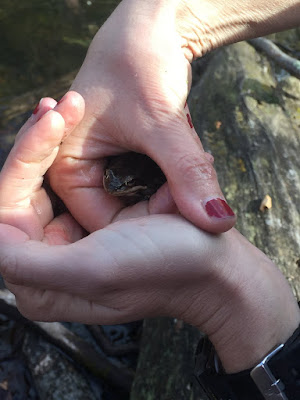TheChristyBel
 |
| One of the First Coltsfoot Blooms of the Season |
Wood Frog
 Looks Like: The Wood Frog has a flat body, moist skin, a pointed head, and webbed feet with un-webbed distal toe joints. Coming a variety of shades of brown and red, Wood Frogs have a black marking over their eyes resembling a robber’s mask. Their coloration is greatly influenced by their surroundings; during mating seasons the females have a lighter red complexion where the males are much darker brown.
Looks Like: The Wood Frog has a flat body, moist skin, a pointed head, and webbed feet with un-webbed distal toe joints. Coming a variety of shades of brown and red, Wood Frogs have a black marking over their eyes resembling a robber’s mask. Their coloration is greatly influenced by their surroundings; during mating seasons the females have a lighter red complexion where the males are much darker brown.
Lives On: Tundra, wet grasslands, and moist woodlands are most favored by Wood Frogs. The Wood Frog uses pools formed by spring rains and snow melt for breeding. Once breeding is over, adults will spend the rest of their season away from water.
Niche: A variety of snakes, waterfowl, heron, raccoon, coyote, and fox have been seen feeding on Wood Frog. The Wood Frog tadpoles fall prey to beetles, giant water bugs, salamanders, turtles, and other frogs.
Threats: Wood Frogs , along with all amphibians, are under ecological pressures due to human activities. Through reforestation, road building, agriculture, and industry development, the Wood Frog's habitat is slowly diminishing. In addition to loss of habitat, acid rain and other forms of air pollution can contaminate breeding pools and seriously damage the adults, eggs, and offspring. Researchers studying the Wood Frog must also take special care in cleaning their equipment and clothing gear in fear of spreading ranaviruses that can kill the frog and other amphibians.
Frequency: This frog is found in 2/3 of the country into Canada and the Arctic Circle. Many of the Wood Frog in the Shawangunks can be found in vernal pools, marshes, and moist woodlands in the Foothills to the Ridge.
 Reproduction: One of the first frog’s to begin the breeding season, the Wood Frog will move to breeding pools usually in a melt or rainwater typically free of fish or other predators. The males will call to females; their calls sound like a “duck-like, quack.” When a attracted, larger female enters the pool, the smaller male will grab onto her back (called “amplexus”). Squeezing her abdomen, the eggs will be released into the water and the male will release sperm into the water to fertilize the egg mass. An egg mass usually contains 1,000 to 2,000 eggs. The egg mass will accumulate together in the shallows of the pools into a raft. Counting the egg mass rafts is a highly efficient way for scientists and researchers to determine population density of the Wood Frog in a given region or area.
Reproduction: One of the first frog’s to begin the breeding season, the Wood Frog will move to breeding pools usually in a melt or rainwater typically free of fish or other predators. The males will call to females; their calls sound like a “duck-like, quack.” When a attracted, larger female enters the pool, the smaller male will grab onto her back (called “amplexus”). Squeezing her abdomen, the eggs will be released into the water and the male will release sperm into the water to fertilize the egg mass. An egg mass usually contains 1,000 to 2,000 eggs. The egg mass will accumulate together in the shallows of the pools into a raft. Counting the egg mass rafts is a highly efficient way for scientists and researchers to determine population density of the Wood Frog in a given region or area.
Fun Fact: Wood frogs, along with several other frogs, undergo a freeze-thaw cycle. Unlike some animals that migrate elsewhere, grow thick fur, or burrow deep underground to sleep over the winter waiting for spring, the Wood Frog seeks cover under leaves and actually freeze and thaw with their surroundings. They stop breathing and their hearts cease to beat. The Wood Frog has a special antifreeze that prevents ice from forming in their cells. At the same time, the Wood Frog’s liver starts making large amounts of glucose (type of sugar) that packs into the cells and props them up. When the weather warms, the Wood Frog will thaw and begin to go about their lives. The Wood Frog is unharmed during this freeze-thaw cycle.
No comments:
Post a Comment